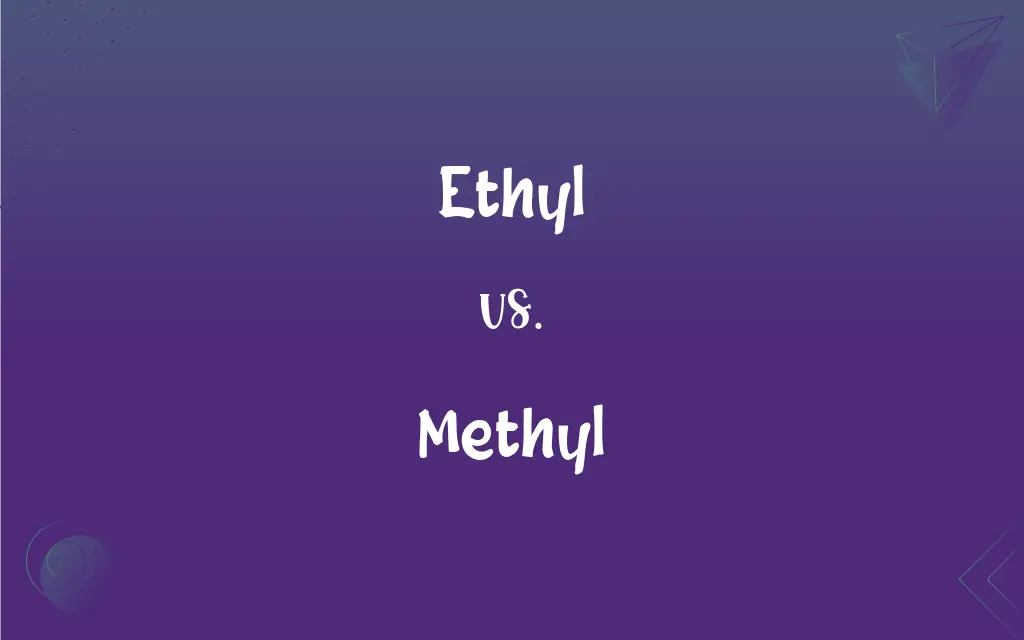Ethyl vs. Methyl: What's the Difference?
Edited by Aimie Carlson || By Harlon Moss || Updated on October 20, 2023
Ethyl is a two-carbon functional group (−CH₂CH₃), while methyl is a one-carbon functional group (−CH₃).

Key Differences
Ethyl, represented by the molecular structure −CH₂CH₃, is a two-carbon alkyl group that can be found in various organic compounds. Methyl, with the molecular structure −CH₃, is a one-carbon alkyl group and is among the simplest alkyl radicals.
Both ethyl and methyl play pivotal roles in organic chemistry, acting as substituents that modify the properties of compounds. However, their structural difference, with ethyl having two carbons and methyl one, often results in varied chemical behaviors.
For instance, compounds with ethyl groups might have different boiling points, melting points, or reactivity compared to those with methyl groups. This is largely attributed to the additional carbon atom in ethyl, which affects molecular interactions.
In industrial applications, both ethyl and methyl groups can be found. Ethyl alcohol, for example, is a common solvent and the type of alcohol found in alcoholic beverages. Methyl alcohol, conversely, is used in industrial applications but is toxic if ingested.
Despite the difference in carbon atoms, both ethyl and methyl are crucial in the study and application of organic chemistry. Their presence or substitution in molecules can drastically influence the properties and applications of the compounds they are part of.
ADVERTISEMENT
Comparison Chart
Number of Carbons
Two
One
Molecular Formula
C₂H₅
CH₃
Example Compound
Ethyl alcohol (Ethanol)
Methyl alcohol (Methanol)
Occurrence in Nature
Common in many organic compounds
Found in many simple organic compounds
Toxicity
Generally non-toxic (depends on the compound)
Can be toxic (e.g., methanol)
ADVERTISEMENT
Ethyl and Methyl Definitions
Ethyl
A two-carbon alkyl group with the formula −CH₂CH₃.
Ethyl alcohol is commonly consumed in beverages.
Methyl
A substituent that influences the properties of organic molecules.
Introducing a methyl group can alter a compound's solubility.
Ethyl
A substituent in organic chemistry modifying compound properties.
Adding an ethyl group can change a molecule's boiling point.
Methyl
Common in many simple organic compounds.
Methyl bromide is used as a pesticide.
Ethyl
A common component in organic synthesis.
Ethyl acetate is a widely used solvent.
Methyl
A one-carbon alkyl group with the formula −CH₃.
Methyl alcohol is used as an industrial solvent.
Ethyl
Often found in alcohols, ethers, and other organic compounds.
Ethyl ether was historically used as an anesthetic.
Methyl
An organic radical derived from methane.
The methyl group is a fundamental part of organic chemistry.
Ethyl
An organic radical derived from ethane.
The ethyl group can be found in various organic molecules.
Methyl
Frequently used in organic synthesis and industry.
Methyl tert-butyl ether is an oxygenate in gasoline.
Ethyl
Relating to or being a hydrocarbon unit, C2H5, that can occur as a substituent in an organic compound or as an ion or radical.
Methyl
Relating to or being the simplest hydrocarbon unit, CH3, that can occur as a substituent in an organic compound or as an ion or radical.
Ethyl
(organic chemistry) The univalent hydrocarbon radical, C2H5, formally derived from ethane by the loss of a hydrogen atom.
Methyl
(organic compound) The univalent hydrocarbon radical, CH3-, formally derived from methane by the loss of a hydrogen atom; a compound or part of a compound formed by the attachment of such a radical.
Ethyl
A monatomic, hydrocarbon radical, C2H5 of the paraffin series, forming the essential radical of ethane, and of common alcohol and ether.
Methyl
A univalent hydrocarbon radical, CH3-, not existing alone but regarded as an essential residue of methane, and appearing as a component part of many derivatives; as, methyl alcohol, methyl ether, methyl amine, etc.
Ethyl
The univalent hydrocarbon radical C2H5 derived from ethane by the removal of one hydrogen atom
Methyl
The univalent radical CH3- derived from methane
FAQs
Which is larger, ethyl or methyl?
Ethyl is larger due to its additional carbon atom.
What is ethyl?
Ethyl is a two-carbon alkyl group represented by −CH₂CH₃.
Can both ethyl and methyl be found in alcohols?
Yes, such as in ethyl alcohol (ethanol) and methyl alcohol (methanol).
Are ethyl and methyl the same?
No, ethyl has two carbons while methyl has one.
Is methyl alcohol safe to drink?
No, methyl alcohol (methanol) is toxic if ingested.
How common is the ethyl group in nature?
It's prevalent in many organic compounds.
How do ethyl and methyl affect molecular properties?
Their presence can alter properties like boiling point, solubility, and reactivity.
Can the presence of ethyl or methyl affect boiling points?
Yes, their presence can influence boiling points of organic compounds.
How is methyl defined?
Methyl is a one-carbon alkyl group with the formula −CH₃.
Where is the ethyl group derived from?
It's derived from ethane.
Is the methyl group widespread in organic compounds?
Yes, it's a fundamental component in many simple organic molecules.
Can the substitution of ethyl and methyl change a compound's solubility?
Yes, introducing or substituting these groups can alter solubility in organic compounds.
Why is ethyl alcohol used in beverages?
Ethyl alcohol (ethanol) is consumable and provides the intoxicating effect in alcoholic drinks.
Why should we avoid methyl alcohol in drinks?
Methyl alcohol is toxic and can lead to poisoning if ingested.
Can ethyl and methyl be used in organic synthesis?
Yes, both groups play crucial roles in organic synthesis and chemistry.
How do ethyl and methyl groups impact industrial applications?
They're used in solvents, fuels, and other compounds that have diverse industrial applications.
Are both ethyl and methyl groups flammable?
Yes, compounds containing these groups, especially in gaseous form, can be flammable.
Are there safety precautions associated with ethyl and methyl compounds?
Yes, depending on the specific compound, precautions might include avoiding ingestion, inhalation, or skin contact.
What's the origin of the methyl group?
It's derived from methane.
Are ethyl and methyl only found in alcohols?
No, they're found in various organic compounds like ethers, esters, and more.
About Author
Written by
Harlon MossHarlon is a seasoned quality moderator and accomplished content writer for Difference Wiki. An alumnus of the prestigious University of California, he earned his degree in Computer Science. Leveraging his academic background, Harlon brings a meticulous and informed perspective to his work, ensuring content accuracy and excellence.
Edited by
Aimie CarlsonAimie Carlson, holding a master's degree in English literature, is a fervent English language enthusiast. She lends her writing talents to Difference Wiki, a prominent website that specializes in comparisons, offering readers insightful analyses that both captivate and inform.































































